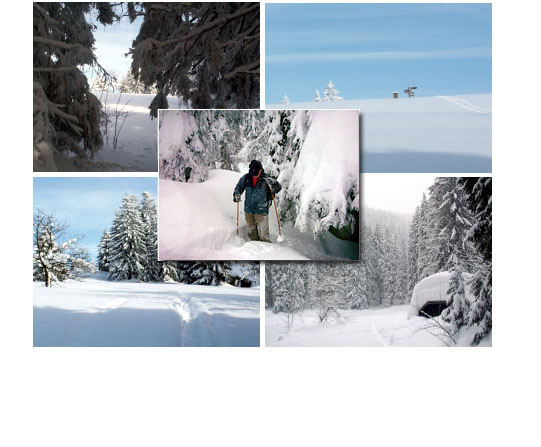» Snowshoeing
Please do not leave the marked trails in the inner area of the NP
Of course there are guided snowshoeing tours.
Further information you will find at
 "www.pronat-zwiesel.de" - veranstaltungen/führungen
"www.pronat-zwiesel.de" - veranstaltungen/führungen
Snowshoe rental:
 Sport Raith - Bayerisch Eisenstein
Sport Raith - Bayerisch Eisenstein

Snowshoeing - some useful facts
Anyone who can walk can also snowshoe walk. It is nonetheless worth bearing one or two things in mind. This applies in particular when you are walking in mountainous areas. The following key points should help.
Beginners
- Take part in guided walks. This will help you to gain experience and enable you to handle the snowshoes safely. In this way you can also often gather valuable information from people who know the locality.
- Practise first on familiar terrain before setting out on a longer walk. Do not overestimate your capabilities. Snowshoeing takes rather more effort than normal walking or hiking.
- When wearing snowshoes, your step should be similar to your normal walking step. Try if possible not to walk with your legs further apart than when you are not wearing snowshoes. Taking long strides with your legs wide apart consumes a lot of energy.
- lt is not necessary for you to lift the snowshoe completely with each step.
- Slight shuffling is permitted and saves energy.
- If possible, avoid slopes at first, especially if they are icy. If there is no other choice, take less steep slopes in a straight line and steep stopes in an oblique line or even in a snaking fashion.
- On a very hard surface you can remove the snowshoes and carry them if you like.
- Plan long walks in advance and take careful note of the weather.
- Ask people in the locality about any possible and not obvious dangers.
- As a holidaymaker in a strange region you should inform your landlord/lady or hotel concierge before setting out on a walk. Only walk when visibility is good and take regular, brief breaks for drinks.
- In winter you lose a large quantity of moisture when breathing.
- Dress warmly and take a change of clothing wlth you if necessary.
- You should wear sensible clothing and carry equipment (water, provisions, compass, sunglasses and suncream, first-aid kit) and a map with you as a matter of course.
- A good torch can also be helpful as it gets dark quickly in winter.
- Trekking poles are a good thing to combine with snowshoes.
- Be considerate of nature. Do not, for example, walk through reafforestations. Bypass feeding stations for wild animals and avoid making noise. Observe marking arrows and signs often set up by local authorities especially for tourists.
- Cross-country skiers will not take kindly to you using their trails as a footpath.
- You will also disturb downhill skiers if you walk across their piste. This also increases the risk of an accident !
Detailed literature on the subject. of “Snowshoeing“ is available from book shops.